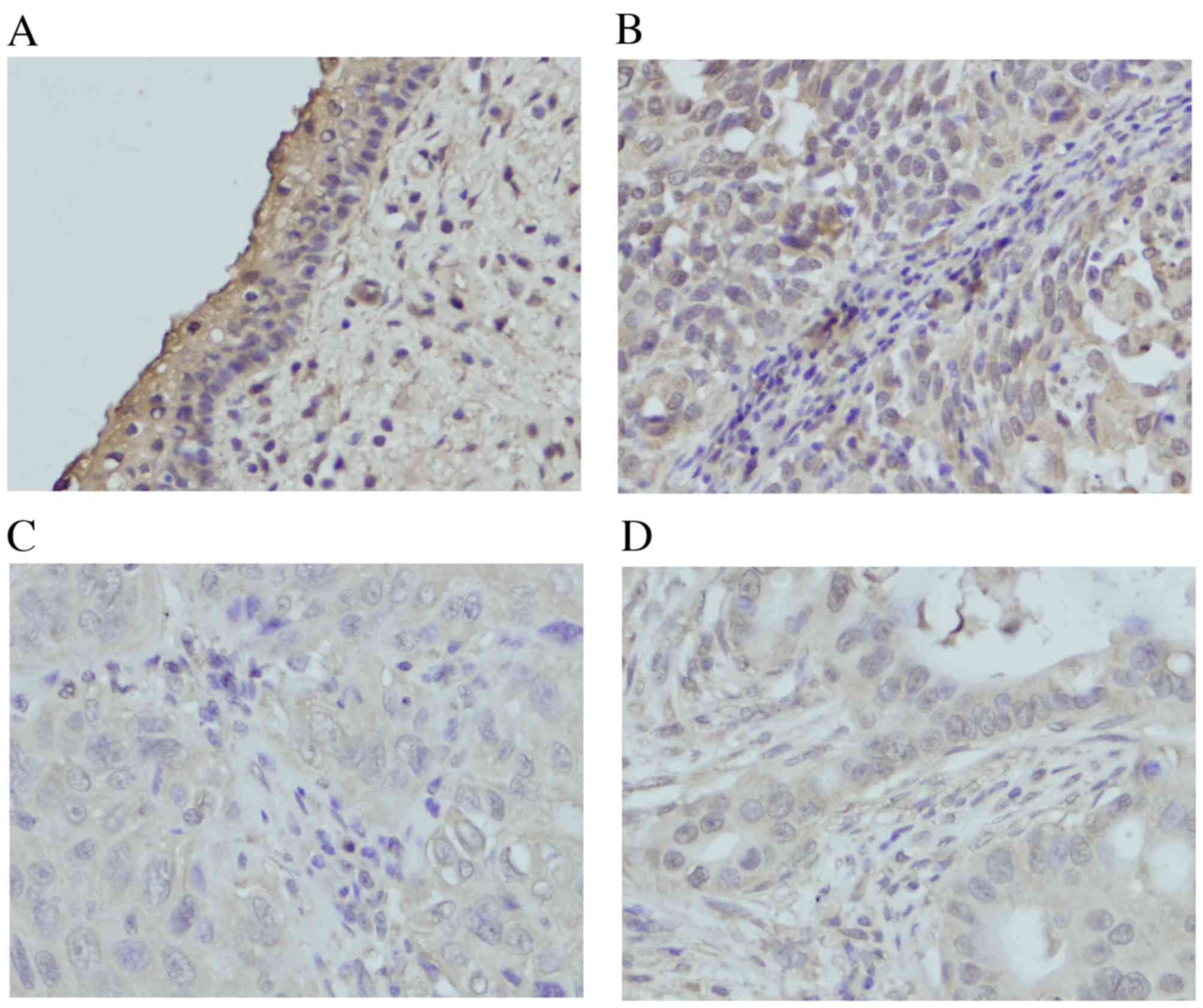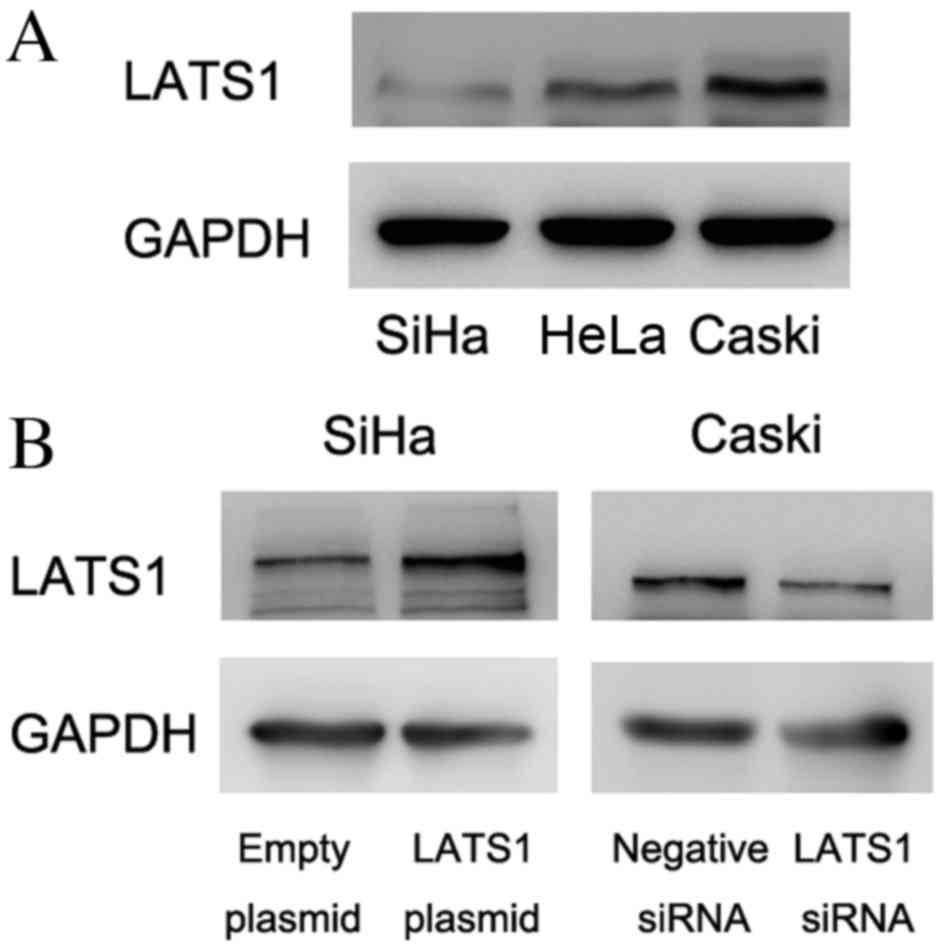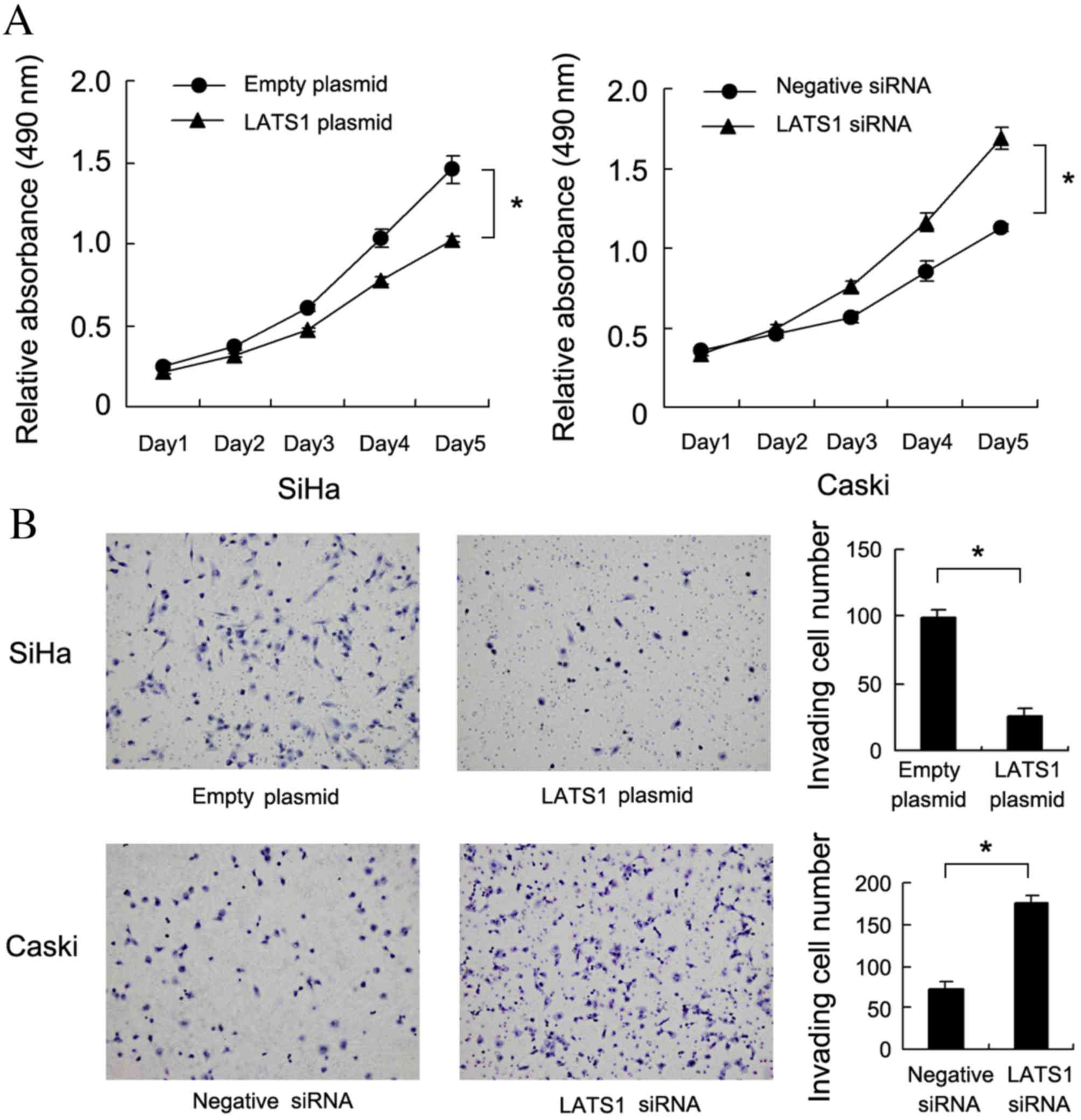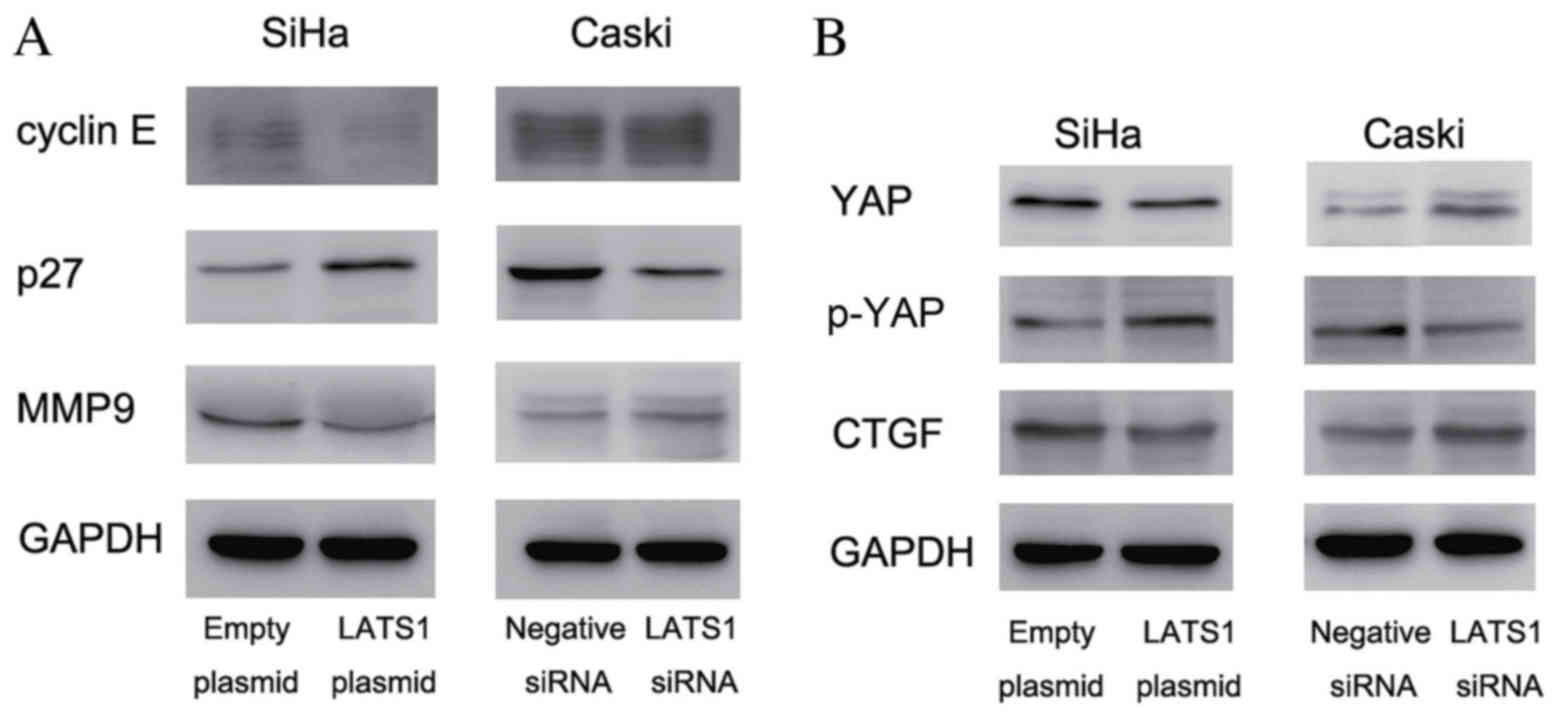LATS1 suppresses proliferation and invasion of cervical cancer
- Authors:
- Published online on: February 8, 2017 https://doi.org/10.3892/mmr.2017.6180
- Pages: 1654-1660
-
Copyright: © Deng et al. This is an open access article distributed under the terms of Creative Commons Attribution License.
Abstract
Introduction
Cervical cancer is the third most common malignancy in women worldwide, with a global incidence of 500,000 and a mortality of 250,000 in 2014 (1). For the earliest stage of cervical cancer, >90% of women survive at least 5 years after diagnosis. However, advanced cervical cancer with invasion or metastasis is associated with a poor prognosis, <20% of stage IV patients survive for ≥5 years (2). Furthermore, despite advances of conventional therapies such as surgical treatment, radiotherapy and chemotherapy, malignant cervical cancers still have high mortality rate, and the mechanism underlying its aggressiveness remains poorly understood. Thus, the identification of novel molecular markers, which is helpful for the development of novel diagnostic and therapeutic strategies, remains an important focus in the current management of this malignancy.
Mammalian Large tumor suppressor kinase 1 (LATS1) and LATS2, the major kinase components of the Hippo pathway, are important in the control of tumor development (3,4) and the cell cycle, via various mechanisms and signaling pathways (5,6). It was previously reported that LATS1 protein was downregulated in various types of cancer, including breast carcinoma (7), colorectal carcinoma (8), gastric cancer (9), non-small cell lung cancer (10) and ovarian serous carcinoma and clear cell carcinoma (11). These results indicated that LATS1 may be an important tumor suppressor in types of human cancer. However, whether LATS1 is a tumor suppressor in cervical cancer remains controversial.
The present study examined LATS1 protein expression in 80 cases of cervical carcinoma and analyzed the association between LATS1 expression and clinicopathological factors. Additionally, gain of function and loss of function experiments were performed to investigate the biological roles of LATS1 in cervical cancer. LATS1 expression was upregulated in SiHa cells and depleted in Caski cells, and the effects on cell proliferation and invasion were then examined. In addition, the molecular signaling pathways underlying these biological effects of LATS1 were investigated.
Materials and methods
Patients and specimens
The protocol of the current study was approved by the Institutional Review Board of Kunming Maternity and Child Care Hospital (Kunming, China). Primary tumor specimens were obtained from 80 patients (mean age, 45.5; range, 28–72) diagnosed with cervical carcinoma who underwent resection in Kunming Maternity and Child Care Hospital between January 2012 and November 2014. Informed consent was obtained. Histological diagnosis was performed on sections stained with hematoxylin and eosin, according to the World Health Organization classification guidelines (12). Clinical and histopathological data were obtained from medical records.
Immunohistochemistry
Cervical cancer tissue specimens were fixed in 10% formalin at room temperature for 24 h and embedded in paraffin. Immunohistochemistry was carried out using Elivision™ plus Polyer HRP IHC kit (Fuzhou Maixin Biotech Co., Ltd., Fuzhou, China) according to the manufacturer-s protocol. Briefly, 4 µm thick tissue sections were deparaffinized and rehydrated using ethanol. Subsequently, antigen retrieval was performed using 0.01 M citrate buffer (pH 6.0) for 2 min. H2O2 was employed to inhibit endogenous peroxide and non-immune goat serum (Fuzhou Maixin Biotech Co., Ltd.) was used to reduce non-specific antibody binding at room temperature for 15 min. Sections were then incubated with LATS1 antibody (1:200; cat. no. 9153; Cell Signaling Technology, Inc., Danvers, MA, USA) at 4°C overnight. Biotinylated anti-rabbit horseradish peroxidase polymer (ready to use; cat. no. 9922; Fuzhou Maixin Biotech Co., Ltd.) was used as a secondary antibody at 37°C for 2 h. Following washing, the peroxidase reaction was developed with 3, 3-diaminobenzidine. Counterstaining with hematoxylin was performed and the sections were dehydrated in ethanol prior to mounting.
Two independent blinded investigators examined all tumor slides randomly. As in previous studies (13,14), immunostaining of LATS1 was scored on a semi-quantitative scale by evaluating the intensity and percentage of tumor cells stained. Cytoplasmic immunostaining was regarded as positive. The intensity of LATS1 staining was scored as follows: 0, weak/negative; 1, moderate; or 2 (strong). Staining percentage, the percentage of tumor cells stained, was scored as follows: 1, 1–25%; 2, 26–50%; 3, 51–75%; or 4, 76–100%. Total score was obtained by multiplying the staining and percentage scores. Specimens with a total score of 5–8 were considered to be positive for LATS1 expression. Specimens with a total score of 0–4 were considered to have low LATS1 expression.
Cell culture and transfection
Caski, HeLa and SiHa cell lines were obtained from the American Type Culture Collection (Manassas, VA, USA). SiHa and HeLa cells were cultured in minimum essential medium (MEM; Invitrogen; Thermo Fisher Scientific, Inc., Waltham, MA, USA) and Caski cells were cultured in RPMI-1640 medium containing 10% fetal bovine serum (Gibco; Thermo Fisher Scientific, Inc.) at 37°C for 2 days. Cells were cultured on sterilized culture plates and were passaged every two days with trypsin.
The plasmid of pCMV6-LATS1 was purchased from (OriGene Technologies, Inc. (Rockville, MD, USA) Plasmid was transfected into cells using Lipofectamine® 3000 reagent (Invitrogen; Thermo Fisher Scientific, Inc.) at 37°C for 48 h. pCMV6 empty vector was used as a negative control. For transient knockdown experiments, oligonucleotide pools of small interfering RNA (siRNA) targeting LATS1 and non-targeting siRNA (cat. no. M-004632-00-0005) were purchased from Dharmacon (Lafayette, CO, USA) and transfected using Lipofectamine® 2000 (Invitrogen; Thermo Fisher Scientific, Inc.) at 37°C for 48 h, according to the manufacturers- protocols.
Western blot analysis
Proteins were extracted and quantified using the Bradford method, and 20 µg protein was separated by SDS-PAGE (5% stacking gel and 10% separating gel). Proteins were transferred to polyvinylidene fluoride membranes and 5% BSA solution (w/v) was used to reduce non-specific antibody binding at room temperature for 1 h. Proteins were incubated overnight at 4°C with antibodies against LATS1 (1:1,000; cat. no. 9153; Cell Signaling Technology, Inc.), phosphorylated-yes associated protein 1 (p-YAP; 1:1,000; cat. no. 4911; Cell Signaling Technology, Inc.), YAP (1:1,000; cat. no. 4912; Cell Signaling Technology, Inc.), p27 (1:1,000; cat. no. 2552; Cell Signaling Technology, Inc.), cyclin E (1:1,000; cat. no. 20808; Cell Signaling Technology, Inc.), connective tissue growth factor (CTGF; 1:1,000; 23936-1-AP; Proteintech, Chicago, Illinois, USA) and matrix metalloproteinase 9 (MMP9; 1:1,000; cat. no. 3852; Cell Signaling Technology, Danvers, MA, USA) and GAPDH (1:1,000; cat. no. sc-25778; Santa Cruz Biotechnology, Inc., Dallas, TX, USA). PVDF membranes were washed using TBST solution (Sigma-Aldrich; Merck Millipore, Darmstadt, Germany) three times for 5 min each. Following incubation with peroxidase-coupled anti-mouse/rabbit IgG (1:2,000; cat. no. 5127/58802; Cell Signaling Technology, Inc., Danvers, MA, USA) at 37°C for 2 h, proteins were visualized using SuperSignal West Dura Extended Duration Substrate (Thermo Fisher Scientific, Inc.) and detected using a DNR Bio-Imaging System (DNR Bio-Imaging Systems, Ltd., Jerusalem, Israel).
MTT assay
Cells were plated in 96-well plates in MEM containing 10% fetal bovine serum at approximately 1,000–1500 cells per well. For the measurement of cell viability, 20 µl MTT solution was added to each well and incubated at 37°C for 4 h. Subsequently, the remaining MTT formazan was dissolved in 150 µl dimethyl sulfoxide. The plate was measured at a wavelength of 490 nm using a plate reader.
Cell invasion analysis
Cell invasion was examined using Transwell assay with 24-well Transwell chambers. Briefly, Transwell chamber inserts were coated using 20–25 µl Matrigel from BD Biosciences (Franklin Lakes, NJ, USA) with a dilution of 1:5. ~48 h after cell transfection, ~1×105 cells were re-suspended in 100 µl of serum-free MEM and were added to the upper chamber. MEM with 10–15% fetal bovine serum was added to the lower chamber. After incubation at 37°C for 16–20 h, cells on the upper side of membranes were removed using a cotton swab and the cells that had invaded through the filter were washed with phosphate-buffered saline and visualized with hematoxylin at room temperature for 5 min. The number of invaded cells was counted in 5 randomly selected high power fields using a light microscope. This experiment was performed in triplicate.
Statistical analysis
SPSS version 11.5 for Windows (SPSS, Inc., Chicago, IL, USA) was used for all statistical analyses. Data was presented as mean ± standard deviation. χ2 test was used to examine potential associations between LATS1 expression and clinicopathological factors and a paired Student-s t-test was used to compare other data generated from LATS1-transfected or knockdown cells. P<0.05 was considered to indicate a statistically significant difference.
Results
Clinical significance of LATS1 in human cervical cancer
LATS1 expression was located in the cytoplasm in normal cervical tissues (Fig. 1A). Of the 80 cervical cancer tissues, 46 of them (45%) exhibited decreased LATS1 staining, although others were positive for LATS1 expression (Fig. 1B-D). The potential association of low LATS1 expression with clinicopathological characteristics was analyzed. The results demonstrated that low LATS1 immunostaining in cervical cancer was significantly associated with primary tumor, node, metastasis (TNM) stage (stages II+III vs. stage I, P=0.0102) and primary tumor (T) stage (TII+III vs. TI, P=0.0217). No significant association was identified between low LATS1 expression and other parameters, including age, histological type and differentiation (Table I).
Table I.Distribution of LATS1 status in cervical carcinoma according to clinicopathological characteristics. |
LATS1 suppresses proliferation and invasion of cervical cancer cells
LATS1 was examined by western blot analysis in cervical cancer cell lines (Fig. 2A). The present study demonstrated that SiHa cells had low LATS1 protein expression and Caski cells had relatively high LATS1 protein expression. To determine its biological roles in cervical cancer cell lines, plasmid transfection was performed in SiHa cells and siRNA knockdown was performed in Caski cells. As presented in Fig. 2B, LATS1 transfection increased protein levels of LATS1 in SiHa cells and siRNA reduced LATS1 protein levels in Caski cells. The MTT assay demonstrated that LATS1 upregulation significantly decreased cell growth rate compared with cells treated with empty plasmid. (SiHa:P=0.019; Caski:P=0.006, Fig. 3A). A Matrigel invasion assay was also performed to assess the effect of LATS1 on cell invasion. As presented in Fig. 3B, LATS1 transfection significantly decreased the invasiveness of SiHa cells compared with cells transfected with empty plasmid (P=0.007), while LATS1 knockdown significantly increased the invasiveness of Caski cells compared with cells treated with negative siRNA (P=0.005).
LATS1 regulates the expression of cyclin E, p27, MMP9 and YAP in cervical cancer cells
In order to investigate the molecular mechanism underlying LATS1-induced cell growth and invasion, the present study examined the expression of growth and invasion-associated proteins. The results demonstrated that the cyclin E expression was notably decreased following LATS1 overexpression in SiHa cells, compared with cells treated with empty plasmid, and increased following LATS1 knockdown in Caski cells, compared with cells treated with negative siRNA. Protein expression of cell cycle inhibitor p27 was increased compared to control following LATS1 transfection in SiHa cells and decreased compared to the control following LATS1 knockdown in Caski cells. (Fig. 4A). The present study also examined invasion-associated protein MMP9, and demonstrated that MMP9 was downregulated in LATS1-transfected SiHa cells and upregulated in LATS1-knockdown Caski cells, compared to respective controls (Fig. 4A). LATS1 is the upstream inhibitor of Hippo signaling. Activation of the Hippo signaling pathway inhibits the expression and function of YAP oncoprotein and suppresses cancer growth and invasion. The current study examined YAP expression, and its downstream factor CTGF, in LATS1 overexpressing and knockdown cervical cancer cells. As presented in Fig. 4B, in LATS1-transfected SiHa cells, CTGF and YAP levels were decreased, compared to the control SiHa cells. In LATS1 knockdown Caski cells, their expression (YAP and CTGF) was upregulated compared with control Caski cells. Changes in the levels of YAP phosphorylation were also examined. Western blot analysis demonstrated that LATS1 increased the phosphorylation of YAP.
Discussion
LATS1 is the mammalian homolog of Drosophila LATS, originally identified as a cell proliferation inhibitor (15). It is a serine/threonine kinase that localizes to the mitotic apparatus. LATS1 may form a complex with cyclin-dependent kinase 1 in early mitosis, decreasing H1 histone kinase activity, which indicates its role as a cell cycle inhibitor (16). LATS1-knockout mice developed sarcomas and ovarian tumors, indicating that it may also function as a tumor suppressor (3). The expression and biological roles of LATS1 have been implicated in a number of human malignancies, including gastric cancer, breast cancer, glioma, renal cell carcinoma and ovarian cancer (9,11,17–19). However, to the best of our knowledge, the involvement of LATS1 in human cervical carcinoma has not been reported. The present study examined LATS1 protein expression in 80 cases of cervical cancer and demonstrated that LATS1 was downregulated in 45% of tissue specimens. Statistical analysis demonstrated that LATS1 downregulation was positively associated with advanced TNM stage and tumor status, indicating that loss of LATS1 is associated with cervical cancer progression. The results of the current study are consistent with previous studies (20–22), indicating that LATS1 may be a potential tumor suppressor in human cervical cancer.
To identify its biological roles in cervical cancer cells, the present study transfected SiHa cells with a LATS1 plasmid and Caski cells were transfected with LATS1 siRNA. Subsequently, the effects on cell proliferation and invasion were examined. Consistent with the immunohistochemical results of the present study, LATS1 transfection significantly inhibited cell growth and invasiveness of SiHa cells, while LATS1 siRNA had the opposite effect in Caski cells. The current study further investigated the potential underlying mechanisms by which LATS1 inhibited cell proliferation and invasion in cervical cancer. Previous studies demonstrated that LATS1 functions as a cell cycle regulator (20,21). Thus, the protein levels of cyclin E and p27 in LATS1-overexpressing SiHa cells and LATS1-knockdown Caski cells were investigated in the present study. The results demonstrated that LATS1 downregulated cyclin E and upregulated p27. Cyclin E facilitates and p27 inhibits cell cycle progression (23,24). Cycle E overexpression is important during cervical cancer proliferation (25), and p27 downregulation has been previously identified in cervical cancer tissues where it may cause cell cycle arrest in cervical cancer cells (26,27). In addition, the present study demonstrated that invasion-associated protein MMP9 was negatively regulated by LATS1 expression. MMP9 is considered to be associated with cervical cancer invasion (28–30). Thus LATS1 may regulate cervical cancer growth and invasion through modulation of cell cycle proteins and MMP9. As LATS1 is the upstream positive regulator of Hippo pathway, the current study investigated changes in the expression levels of downstream proteins, including YAP and CTGF. The results demonstrated that LATS1 overexpression inhibited CTGF and YAP expression, and increased YAP phosphorylation in SiHa cells compared with control SiHa cells. YAP is a positive regulator of growth and invasion in various types of human cancers, including cervical cancer (31). CTGF is the target of YAP and functions as a growth promoter. CTGF has been reported to positively regulate the cell cycle and MMP proteins (32,33). Thus, the role of LATS1 in cervical cancer invasion and proliferation may depend on its regulation on YAP, and its downstream target CTGF.
In conclusion, LATS1 is downregulated in human cervical cancers and LATS1 expression is associated with TNM stage. LATS1 inhibited cervical cancer cell proliferation and invasion, potentially through regulation of p27 and MMP9. LATS1 may activate the Hippo pathway through downregulation of YAP and CTGF. Loss of LATS1 may serve as an indicator of malignant phenotype in human cervical cancer.
Acknowledgements
The present study was supported by the Yunnan Provincial Science and Technology Project Fund (grant no. 2014FB200).
References
|
Siegel R, Ma J, Zou Z and Jemal A: Cancer statistics, 2014. CA Cancer J Clin. 64:9–29. 2014. View Article : Google Scholar : PubMed/NCBI | |
|
Song C, Zhu S, Wu C and Kang J: Histone deacetylase (HDAC) 10 suppresses cervical cancer metastasis through inhibition of matrix metalloproteinase (MMP) 2 and 9 expression. J Biol Chem. 288:28021–28033. 2013. View Article : Google Scholar : PubMed/NCBI | |
|
St John MA, Tao W, Fei X, Fukumoto R, Carcangiu ML, Brownstein DG, Parlow AF, McGrath J and Xu T: Mice deficient of Lats1 develop soft-tissue sarcomas, ovarian tumours and pituitary dysfunction. Nat Genet. 21:182–186. 1999. View Article : Google Scholar : PubMed/NCBI | |
|
Huntoon CJ, Nye MD, Geng L, Peterson KL, Flatten KS, Haluska P, Kaufmann SH and Karnitz LM: Heat shock protein 90 inhibition depletes LATS1 and LATS2, two regulators of the mammalian hippo tumor suppressor pathway. Cancer Res. 70:8642–8650. 2010. View Article : Google Scholar : PubMed/NCBI | |
|
Furth N, Bossel B, en-Moshe N, Pozniak Y, Porat Z, Geiger T, Domany E, Aylon Y and Oren M: Down-regulation of LATS kinases alters p53 to promote cell migration. Genes Dev. 29:2325–2330. 2015. View Article : Google Scholar : PubMed/NCBI | |
|
Visser S and Yang X: LATS tumor suppressor: A new governor of cellular homeostasis. Cell Cycle. 9:3892–3903. 2010. View Article : Google Scholar : PubMed/NCBI | |
|
Morinaga N, Shitara Y, Yanagita Y, Koida T, Kimura M, Asao T, Kimijima I, Takenoshita S, Hirota T, Saya H and Kuwano H: Molecular analysis of the h-warts/LATS1 gene in human breast cancer. Int J Oncol. 17:1125–1129. 2000.PubMed/NCBI | |
|
Wierzbicki PM, Adrych K, Kartanowicz D, Stanislawowski M, Kowalczyk A, Godlewski J, Skwierz-Bogdanska I, Celinski K, Gach T, Kulig J, Korybalski B and Kmiec Z: Underexpression of LATS1 TSG in colorectal cancer is associated with promoter hypermethylation. World J Gastroenterol. 19:4363–4373. 2013. View Article : Google Scholar : PubMed/NCBI | |
|
Xu ZP, Zhu JS, Zhang Q and Wang XY: A breakdown of the Hippo pathway in gastric cancer. Hepatogastroenterology. 58:1611–1617. 2011. View Article : Google Scholar : PubMed/NCBI | |
|
Lin XY, Zhang XP, Wu JH, Qiu XS and Wang EH: Expression of LATS1 contributes to good prognosis and can negatively regulate YAP oncoprotein in non-small-cell lung cancer. Tumour Biol. 35:6435–6443. 2014. View Article : Google Scholar : PubMed/NCBI | |
|
Xu B, Sun D, Wang Z, Weng H, Wu D, Zhang X, Zhou Y and Hu W: Expression of LATS family proteins in ovarian tumors and its significance. Hum Pathol. 46:858–867. 2015. View Article : Google Scholar : PubMed/NCBI | |
|
Puppo P, Conti G, Francesca F, Mandressi A and Naselli A: AURO. it guideline committee: New Italian guidelines on bladder cancer, based on the World Health Organization 2004 classification. BJU Int. 106:168–179. 2010. View Article : Google Scholar : PubMed/NCBI | |
|
Bocchi EA, Tanigawa RY, Brandão SM, Cruz F, Issa V, Ayub-Ferreira S, Chizzola P, Souza G, Fiorelli AI, Bacal F, et al: Immunohistochemical quantification of inflammatory cells in endomyocardial biopsy fragments after heart transplantation: A new potential method to improve the diagnosis of rejection after heart transplantation. Transplant Proc. 46:1489–1496. 2014. View Article : Google Scholar : PubMed/NCBI | |
|
Roussel AJ, Knol AC, Bourdeau PJ and Bruet V: Optimization of an immunohistochemical method to assess distribution of tight junction proteins in canine epidermis and adnexae. J Comp Pathol. 150:35–46. 2014. View Article : Google Scholar : PubMed/NCBI | |
|
Justice RW, Zilian O, Woods DF, Noll M and Bryant PJ: The Drosophila tumor suppressor gene warts encodes a homolog of human myotonic dystrophy kinase and is required for the control of cell shape and proliferation. Genes Dev. 9:534–546. 1995. View Article : Google Scholar : PubMed/NCBI | |
|
Tao W, Zhang S, Turenchalk GS, Stewart RA, St John MA, Chen W and Xu T: Human homologue of the Drosophila melanogaster lats tumour suppressor modulates CDC2 activity. Nat Genet. 21:177–181. 1999. View Article : Google Scholar : PubMed/NCBI | |
|
Ji T, Liu D, Shao W, Yang W, Wu H and Bian X: Decreased expression of LATS1 is correlated with the progression and prognosis of glioma. J Exp Clin Cancer Res. 31:672012. View Article : Google Scholar : PubMed/NCBI | |
|
Takahashi Y, Miyoshi Y, Takahata C, Irahara N, Taguchi T, Tamaki Y and Noguchi S: Down-regulation of LATS1 and LATS2 mRNA expression by promoter hypermethylation and its association with biologically aggressive phenotype in human breast cancers. Clin Cancer Res. 11:1380–1385. 2005. View Article : Google Scholar : PubMed/NCBI | |
|
Chen KH, He J, Wang DL, Cao JJ, Li MC, Zhao XM, Sheng X, Li WB and Liu WJ: Methylation-associated inactivation of LATS1 and its effect on demethylation or overexpression on YAP and cell biological function in human renal cell carcinoma. Int J Oncol. 45:2511–2521. 2014.PubMed/NCBI | |
|
Visser-Grieve S, Zhou Z, She YM, Huang H, Cyr TD, Xu T and Yang X: LATS1 tumor suppressor is a novel actin-binding protein and negative regulator of actin polymerization. Cell Res. 21:1513–1516. 2011. View Article : Google Scholar : PubMed/NCBI | |
|
Hao Y, Chun A, Cheung K, Rashidi B and Yang X: Tumor suppressor LATS1 is a negative regulator of oncogene YAP. J Biol Chem. 283:5496–5509. 2008. View Article : Google Scholar : PubMed/NCBI | |
|
Xia H, Qi H, Li Y, Pei J, Barton J, Blackstad M, Xu T and Tao W: LATS1 tumor suppressor regulates G2/M transition and apoptosis. Oncogene. 21:1233–1241. 2002. View Article : Google Scholar : PubMed/NCBI | |
|
Lopez-Beltran A, MacLennan GT and Montironi R: Cyclin E as molecular marker in the management of breast cancer: A review. Anal Quant Cytol Histol. 28:111–114. 2006.PubMed/NCBI | |
|
Guan X, Wang Y, Xie R, Chen L, Bai J, Lu J and Kuo MT: p27 (Kip1) as a prognostic factor in breast cancer: A systematic review and meta-analysis. J Cell Mol Med. 14:944–953. 2010. View Article : Google Scholar : PubMed/NCBI | |
|
Zubillaga-Guerrero MI, Alarcón-Romero Ldel C, Illades-Aguiar B, Flores-Alfaro E, Bermúdez-Morales VH, Deas J and Peralta-Zaragoza O: MicroRNA miR-16-1 regulates CCNE1 (cyclin E1) gene expression in human cervical cancer cells. Int J Clin Exp Med. 8:15999–16006. 2015.PubMed/NCBI | |
|
Prasad SB, Yadav SS, Das M, Modi A, Kumari S, Pandey LK, Singh S, Pradhan S and Narayan G: PI3K/AKT pathway-mediated regulation of p27(Kip1) is associated with cell cycle arrest and apoptosis in cervical cancer. Cell Oncol (Dordr). 38:215–225. 2015. View Article : Google Scholar : PubMed/NCBI | |
|
van De Putte G, Holm R, Lie AK, Tropé CG and Kristensen GB: Expression of p27, p21, and p16 protein in early squamous cervical cancer and its relation to prognosis. Gynecol Oncol. 89:140–147. 2003. View Article : Google Scholar : PubMed/NCBI | |
|
Zhu D, Ye M and Zhang W: E6/E7oncoproteins of high risk HPV-16 upregulate MT1-MMP, MMP-2 and MMP-9 and promote the migration of cervical cancer cells. Int J Clin Exp Pathol. 8:4981–4999. 2015.PubMed/NCBI | |
|
Pahne-Zeppenfeld J, Schröer N, Walch-Rückheim B, Oldak M, Gorter A, Hegde S and Smola S: Cervical cancer cell-derived interleukin-6 impairs CCR7-dependent migration of MMP-9-expressing dendritic cells. Int J Cancer. 134:2061–2073. 2014. View Article : Google Scholar : PubMed/NCBI | |
|
Roomi MW, Monterrey JC, Kalinovsky T, Rath M and Niedzwiecki A: In vitro modulation of MMP-2 and MMP-9 in human cervical and ovarian cancer cell lines by cytokines, inducers and inhibitors. Oncol Rep. 23:605–614. 2010.PubMed/NCBI | |
|
He C, Mao D, Hua G, Lv X, Chen X, Angeletti PC, Dong J, Remmenga SW, Rodabaugh KJ, Zhou J, et al: The Hippo/YAP pathway interacts with EGFR signaling and HPV oncoproteins to regulate cervical cancer progression. EMBO Mol Med. 7:1426–1449. 2015. View Article : Google Scholar : PubMed/NCBI | |
|
Zhen Y, Ye Y, Yu X, Mai C, Zhou Y, Chen Y, Yang H, Lyu X, Song Y, Wu Q, et al: Reduced CTGF expression promotes cell growth, migration, and invasion in nasopharyngeal carcinoma. PLoS One. 8:e649762013. View Article : Google Scholar : PubMed/NCBI | |
|
Tsai HC, Su HL, Huang CY, Fong YC, Hsu CJ and Tang CH: CTGF increases matrix metalloproteinases expression and subsequently promotes tumor metastasis in human osteosarcoma through down-regulating miR-519d. Oncotarget. 5:3800–3812. 2014. View Article : Google Scholar : PubMed/NCBI |













